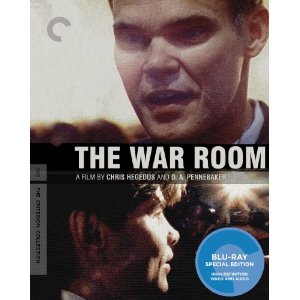Home Video Hovel- The War Room
In discussing political campaigns, it’s easy for both campaign workers and voters to lose the forest for the trees, and vice versa We all get caught up in the day-to-day who’s-up-who’s-down of it all that we forget how important the whole affair is. But in an effort to be constantly reminded of how petty political campaigning can be, we also forget how damn entertaining it can be, too. Chris Hegedus and D.A. Pennebaker’s The War Room is the perfect marriage of the two. At one moment, we might be caught up in what kind of campaign signs make for a better wide shot at the Democratic National Convention, but in another, communications director George Stephanopoulos reminds his staff that because of their efforts, more kids will get to go to better schools. And it’s easy from a distance to look back and say he’s full of it, but in tackling Bill Clinton’s 1992 campaign for president with the approach that they did, Hegedus and Pennebaker let us look right in his eyes and see that he absolutely means it. They reveal that however much campaign promises are inevitably broken, much like a doomed marriage, nobody gets into it expecting to fail.
Louis Menand, in his essay accompanying The Criterion Collection’s new Blu-ray release of The War Room, struggles over how to classify the kind of films Hegedus and Pennebaker make. He notes that any label implies that the filmmakers set out to make a certain type of film when they are really just “following someone around,” but any first-year film studies student will tell you that the lack of a decision is still a decision. I’d argue the filmmakers knew exactly what kind of film they were making, even if they didn’t know what exactly it’d be about. Further, it’s pretty obvious that they have an opinion to add as well. It’s not long into The War Room that Pennebaker and Hegedus start making explicit decisions to paint their subjects in a certain light, aligning them visually with the American flag or pumping the campaign theme song (Fleetwood Mac’s “Don’t Stop (Thinking About Tomorrow)”) as Stephanopoulos and campaign strategist James Carville emerge from the DNC. I have no personal qualms with a filmmaker taking a political stance – I rather prefer it in many cases, this included – but to insist that the filmmakers just followed someone around is ignoring some pretty major active decisions beyond the obvious passive ones.
The star of The War Room is, of course, the legendary James Carville, and he’s as rabid here as he is on any current talk show. Carville is the kind of person that, were he a fictional character in a politically-driven film, would seem totally unrealistic; that’s how far removed he is from the rest of the staff. But without turning this whole review into a political diatribe, he was also the shot in the arm the Democratic party continues to need – someone willing to fight like a Republican. Political campaigning is an exciting field already, but Carville ensures it’s never boring.
Criterion’s new Blu-ray is pretty marvelous. Shot on 16mm, there’s only so “good” The War Room is going to look, but for those of us who really, genuinely love the 16mm format, it’s wonderful to see it looking as grainy and bleached-out as it can. The high definition transfer also makes clear something that’s true of any documentary – the incorporation of footage from other sources. The footage that Pennebaker and company shot themselves looks the best, by far, and there’s a slow degradation in the quality of the stock when they incorporate unused footage from Feed, the 1992 documentary that had more direct access to Clinton himself, and even further when pulling from TV sources. It doesn’t terribly affect the viewing experience, and it helps anyone who wants to study documentary editing, so letting those characteristics remain distinguished was certainly a good call. The film is presented in its original aspect ratio, 1.33:1.
The audio presentation certainly presents some challenges, but they were clearly working with a great master, as the many distinct voices come through clearly, and their position in any given room – even if they’re not seen – is made totally clear. It’s presented in stereo, and occasionally you’ll hear more a prominent voice from the left channel only, but it’s not a major concern and it doesn’t happen often. On the whole, it’s actually a rather dynamic track. Obviously this owes greatly to the sound team during production, but it could have been bungled in the transfer to Blu-ray, where i’s presented uncompressed.
I was a little let down by the special features, but there are enough good ones to recommend the whole package. The biggest one is the 2008 documentary, Return to the War Room, in which Pennebaker and Hegedus take a more traditional, talking-heads style approach to see where everyone’s at sixteen years and three, verging on four, election cycles later. It’s a good idea, and on the whole anyone who enjoyed the original film will get a lot out of it, but they spend far too much time recapping the documentary, way beyond reminding people of the necessary story beats. Maybe let this sit on the shelf for a few months (or years) to really get the most out of it.
We get a short feature with campaign strategist Stanley Greenberg (who worked on the Clinton, Gore, and Kerry campaigns) on the evolution of polling, which is crack for people like me, who are eagerly anticipating not only the upcoming political showdown but the endless analysis that will follow. Your mileage may vary.
An excerpt is provided from a panel hosted by the William J. Clinton Foundation, featuring several people from the film (including Carville), but the bulk of its rather long running time features Bill Clinton, well…kind of rambling. I dig Clinton, and we get a lot of the classic, no-nonsense liberal phrases that made him such a viable candidate, but it certainly does wear after awhile.
The best section presents some new interview pieces Criterion produced. In the first, they sit down with Hegedus, Pennebaker, and producers R.J. Cutler and Wendy Ettinger, who all pretty much just trade memories on the making of the film. It sounds like it might just be a big old trip down memory lane, but the effort to actually, physically make a film like this is tremendous and and this conversation provides a lot of great anecdotes and insights. In another segment, Criterion talks to producer Frazer Pennebaker, who covers a lot of the ground from a production standpoint in nine short minutes, and finally, they speak with cameraman Nick Doob (referred to only as “Doob” here), who talks about his unique ability to blend into crowds unnoticed, which allowed him to get past security and film Clinton’s victory speech.
Finally, we get a booklet with the previously-mentioned essay by Louis Menand, a staff writer at The New Yorker. I found his conclusions a little general and fawning, even for a Criterion essay, and it doesn’t really add much of value to the package.
Lastly, I just want to point out that the design of this package is outstanding, even for a Criterion package.
The War Room is a really wonderful movie, particularly if you’re interested in politics (and why wouldn’t you be). Criterion’s new Blu-ray presentation does a lot to cement its value as documentary and as art – just seeing the difference in the footage they used shows the care with which Pennebaker and company film their subjects. The special features are a little hit-or-miss, but the ones that hit really hit. If you’ve never seen it before, well, ‘tis the season and all that.






























